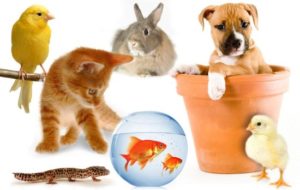27 interesting facts about pets
 By pets, they often mean not only the inhabitants of city apartments, but also any other living creatures. People began to tame different mammals and birds a long time ago, in immemorial times, and since then have achieved considerable success in this. This process continues now, but not all animals lend themselves to domestication, despite all the efforts of breeders.
By pets, they often mean not only the inhabitants of city apartments, but also any other living creatures. People began to tame different mammals and birds a long time ago, in immemorial times, and since then have achieved considerable success in this. This process continues now, but not all animals lend themselves to domestication, despite all the efforts of breeders.
Dogs have a very sensitive nose, but not as sensitive as cows. Ordinary homemade cows can smell up to ten kilometers.
The dog’s fingerprint is as unique as human fingerprints.
Pets can sometimes be carriers of dangerous diseases. Toxarosis, which affects dogs and cats, can lead to blindness, for example.
Domestic cats meow only when they want to attract people’s attention. When communicating with each other, they do not use these sounds.
Most cats do not like water, but Turkish Van (it is such a breed) for the most part love to swim.
In the UK, a pet owner may be fined if the police determine that the pet is obese due to improper care.
In aquariums, mollusks are often kept together with fish, since mollusks perfectly clean the water.
Many decorative rabbits like to play catch-up. For lack of relatives, the owner can become an object for the game.
Due to the peculiarities of the neck structure, ordinary pigs, like decorative minipigs, do not know how to lift their heads and look up.
Pets like rats are very social creatures. Alone, they languish from longing. They should always be kept at least in two, at least so that they have a company.
Goldfish are the most popular inhabitants of home aquariums in the world. They do not even need to heat the water, as the room temperature completely suits them.
Common mold is a deadly poison for many pets.
Do not give dogs chocolate. They love him, but he is harmful to them and even dangerous.
People have long domesticated horses. So long ago that their wild ancestors became extinct, and little is known to scientists about them at all.
Amphibian lovers sometimes keep horned Argentine frogs as pets. But playing with them is not always successful – with sizes over 15 cm, these creatures are quite aggressive, and they bite very painfully.
Zebras, unlike horses, are not tame. But in Africa, hybrids of horses and zebras are bred with which you can get along.
Both domestic and wild ducks have one interesting feature – only females quack. Males do not know how to quack.
The smell of rats, both wild and domestic, is so acute that they can smell one millionth of a poison in food.
Guinea pigs, popular pets, were tamed by the Incas in South America many thousands of years ago. But they were not kept as pets – the meat of these rodents is still considered a delicacy in a number of Latin American countries.
The eyes of rabbits are unique in that, thanks to their location, the animal can even see what is happening behind him, without turning its head.
Centenarians among domestic animals are turtles. They sometimes live for several hundred years. So, Charles Darwin, the creator of the theory of evolution, died in 1882, and his domestic tortoise, Garietta, died in 2006.
Horses are able to recognize themselves and their relatives in photographs.
Domestic pigs are often used to find truffles, the most expensive mushrooms in the world.
Apparently, the first domestic animal was a wild wolf, once tamed by primitive people. Countless breeds of dogs went from him.
The world’s first most popular place among all domestic animals is shared by cats and dogs.
In all developed countries, the law prohibits keeping pets that can be dangerous for others, and sometimes for the owners themselves.
Hearing in dogs is about ten times more acute than in humans.



























